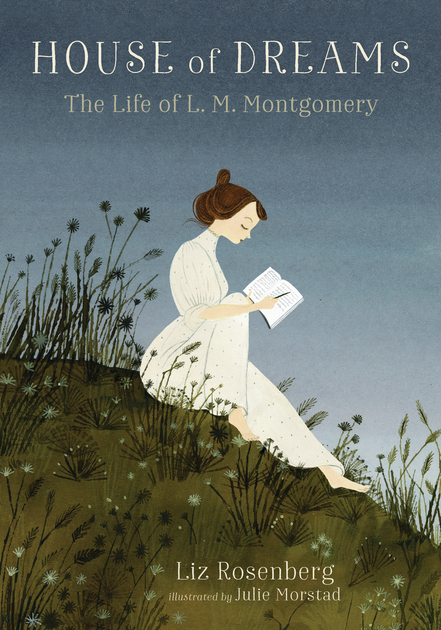Liz Rosenberg

When I read fiction, I like to know a bit about the author, just to have an idea of his or her perspective. Often, the blurb on the book jacket is enough for context. I’m not typically one who needs or wants all the intimate details of an author’s life, though it can be interesting to know a little about how our most beloved books came to be written.
My trip to Prince Edward Island was a pilgrimage to Avonlea and Green Gables, not a quest for more of L. M. Montogomery’s private life. I wanted to experience the atmosphere of the Island, stroll down Lover’s Lane, and sit on the banks of the Lake of Shining Waters. I love to try to feel what it was like to live in former times, so the museums at Montgomery’s birthplace and Green Gables, and her grandparents’ post office were also appealing.
I picked up House of Dreams because it was in the children’s section of our library, and I was curious how the author would approach Montgomery’s life in a book for children. The inside jacket description says, “House of Dreams is the first biography of L. M. Montgomery for young readers to include the recent revelations about the author’s last days and to encompass the complexity of a brilliant and checkered life.”
Though the book is 325 pages long, Rosenberg starts out at a fairly good pace, not bogging down in minutiae that might be tedious for young readers. However, about a third of the way through, I started to feel that, “to encompass the complexity of a brilliant and checkered life,” meant, Let’s talk about every one of Maud’s many romances. Maud seems to have had as many “innocent” flirtations leading to marriage proposals as Emily Starr had.
While most of these relationships were conducted with restraint, and discussed in this book without much detail, I began to wonder what aged children the author and the publisher classify as “young people.” Particularly disturbing is chapter thirteen, “The Year of Mad Passion.” What young reader needs to know that Maud, “read with fascination,” a book about ,“a woman who found freedom in something as taboo as sexuality”?
We are told that, while teaching at Lower Bedeque, she carried on an illicit relationship with a man with whose family she boarded. Illicit because she and he were both quietly engaged to someone else. They met whenever they could, and kissed and touched, until he began coming into her room to lie beside her in bed. He finally pushed things far enough that Maud had to order him out of her room, and the relationship ended.
When Maud does marry Ewan Macdonald, we find out, “that Maud suffered from painful cystitis, known as the ‘honeymoon disease,’ so it’s likely that she and Ewan were sexually active. But theirs was, from the start, a marriage of companionship rather than a meshing of souls.” I can’t imagine who would actually be helped by this knowledge. I believe it’s an accepted fact that Montgomery didn’t find her husband to be a kindred spirit, but that was enough information for her fans for many years without adding details about their sex life. Just because it’s possible to find these details by scouring Montgomery’s diaries, doesn’t mean it needs to be broadcast, particularly to children.
I had already gathered from various sources that perhaps Maud wasn’t the perfect mother. Who is? Other sources imply that her firstborn was rather a disappointment. Do teen girls need to know that, “There was an awful incident in which he exposed himself to one of the domestic household workers”?
Rosenberg goes into some detail about Maud’s and Ewan’s dark mental problems. We get a fairly detailed list of the drugs they took to try to treat mental and physical disorders.
And finally, we’re told that, in September 2008, Montgomery’s granddaughter, “Kate Macdonald Butler, came forward with the family’s permission to declare Maud’s death a suicide, and to describe her grandmother’s long struggle against depression. ‘I have come to feel very strongly that the stigma surrounding mental illness will be forever upon us as a society until we sweep away the misconception that depression happens to other people, not us — and most certainly not to our heroes and icons,’ Kate wrote.”
I had meant to write a more balanced review of this book, to alert parents to some details that might be disturbing to young girls, but also to point out some of its merits. However, in the end I felt like this was a piece of “soft” iconoclasm. If there can be such a thing. Smearing mud on the heroine’s portrait?
Perhaps it’s simply Twenty-first Century chronological snobbery. Poor Maud! If only she had lived in our more enlightened times, everything might have been different. No doubt. Montgomery probably wouldn’t be able to find a publisher for a clean, innocent, beauty-loving Anne Shirley today. Anne would have to be jaded and sophisticated.
Also from the book jacket: “For many years, little was known about Maud’s personal life. Her childhood was spent with strict, unaffectionate grandparents, and her reflections on writing, her lifelong struggles with anxiety and depression, her ‘year of mad passion,’ and her troubled married life remained locked away, buried deep within her unpublished journals.” Perhaps we should have some respect for her discretion, and allow our heroes and heroines to rest with some dignity intact.
Thank you, Diane, for your kind and lucid observations about this L. M. Montgomery biography for “young people.” I found it very helpful. It shows the sad state that we’ve come to when biographers (and publishers) feel they must include sexual problems or deviancies to make the subject matter “relevant” to young readers today. Is there room for innocence and sacred privacy in marriage, if everything will be exposed and expounded upon 100 years later?
Sadly, it seems that nothing is sacred.